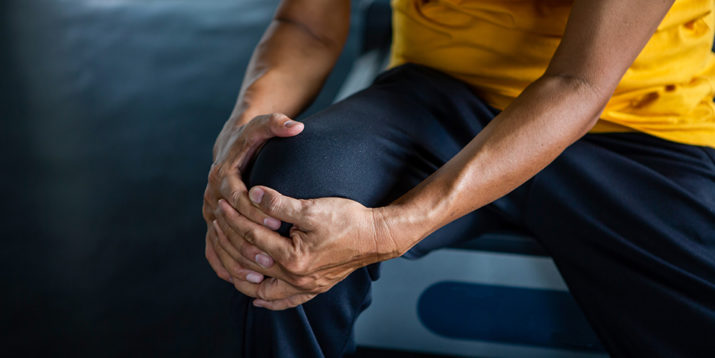How to Work Out With a Knee Injury

Our knees play a role in most training modalities, so you may wonder how to work out with a knee injury — or if that’s even possible (or advisable).
Are any lower-body exercises okay, or do you need to stick with upper body workouts? Is swimming your only option for cardio?
And how can you exercise while managing knee pain when it flares up?
The good news is, you can do more to stay active than you may think. Here’s what the experts suggest when you’re dealing with knee pain.
1. Consult the Pros
Before doing anything, talk to your doctor to make sure that working out is appropriate for you right now. Once you have their go-ahead, you may also want to consult a physical therapist (PT).
“They can take you through a proper protocol of strengthening and loading the injured tissue to ensure your knee is fully recovered so you can return fully to the things you love to do,” explains Lauren Lobert Frison, DPT, OMPT, CSCS, and owner of APEX Physical Therapy.
A PT can also help modify strength and cardio exercises, so you can work toward your fitness goals without worsening an injury.
2. Listen to Your Body
Throughout any activity, tune in to how you feel physically. “If your knee feels fine, continue,” says physical therapist and strength coach Leada Malek, DPT, CSCS, SCS. “But if you start to feel a twinge or increase in symptoms, switch muscle groups — maybe do some core work — so the knee gets a break.”
If you still feel aggravation when you return to the original exercise, she adds, don’t do any more exercises that work your knees right now.
Once you wrap up a workout, be mindful of any new pain, clicking, or swelling around the knees or return of old symptoms in the next day or so.
“This should be a warning sign to take a step back and re-evaluate your exercises, form, intensity, or volume,” Malek says.
3. Train to Prevent Future Injuries
Doing exercises to strengthen your knees can help protect against injury.
“If you have knee pain, you absolutely must keep your lower body muscles both strong and mobile,” says Lauren Shroyer, MS, ATC, senior director of product development at the American Council on Exercise. “If you avoid exercise altogether, your lower body becomes weaker, and you are likely to see an increase in knee pain.”
But start slowly. Shroyer recommends adding one lower-body exercise at a time. “That way, if you do have irritation the next day, it will be clear to you which exercise is the culprit,” she says.
Lobert Frison recommends starting with exercises such as resistance-band leg presses, step-ups, step-downs, and half-squats.
Single-leg exercises can help ensure you’re not compensating with your non-affected leg, Lobert Frison adds.
4. Modify Your Workouts
High-impact workouts, like running on asphalt or jumping, could make your knees hurt more, Malek says. She suggests jogging or running at a slower pace on a track or trail if you want to get in miles.
If you’re jumping, do so at a lower height and on a softer surface, if possible.
You may also need to nix any exercises that include deep knee bends, such as low squats and lunges. These increase the compression of the knee cap within its groove and can set off an irritated knee, Malek explains.
“Staying a bit high in all these movements lessens the pressure,” she adds.
And again, stop if you feel any knee pain.
5. Try Low-Impact Cardio
Rowing machines, bikes, ellipticals, and swimming are all great alternatives when you can’t run.
“With simple walking, you place three times your body weight through your knee with each step,” says James Gladstone, M.D., chief of sports medicine at Mount Sinai. “If you run, jump, or go upstairs, it can be six to eight times your body weight.”
To ensure you’re getting a workout similar to the cardiovascular challenge of running or jogging, Lobert Frison suggests using a heart rate monitor or your rate of perceived exertion (RPE) to gauge your intensity.
6. Strength Train (Carefully!)
Just because you should avoid deep squats doesn’t mean you can’t make strength gains while nursing a knee injury.
Malek suggests half-squats, clamshells, glute bridges, hip thrusts, and deadlifts to work your lower body. Core work is typically also okay, since most movements don’t tax your knees.
As a bonus, working your glutes and core will help build total-body stability, which can help with knee health, Gladstone says.
As always, focus on using proper form and other ways to avoid injury when resistance training.
7. Don’t Skip Your Warm-up
Preparing your body for a workout is always a good idea, but even more so if you have any pain or injuries.
“[Warming up] allows for some priming of the muscles that are important to help reduce the load to the knee in the exercises to come,” Malek explains. “Without a warm-up, there is an increased risk for injury.”
8. Consider Foam Rolling
Although it can’t speed up recovery from a knee injury, if your muscles are sore or tight, using a foam roller may help you feel better. Malek recommends rolling your quads, hamstrings, and calves.
“By facilitating blood flow to these muscles, they can relax more,” she says. “A less tense quad means less tension across the kneecap and usually less knee pain.”
The content of this article is meant for informational purposes only and is not intended to be a substitute for professional medical advice, diagnosis, or treatment. Always seek the advice of your physician or other qualified health provider with any questions you may have regarding your specific condition.



